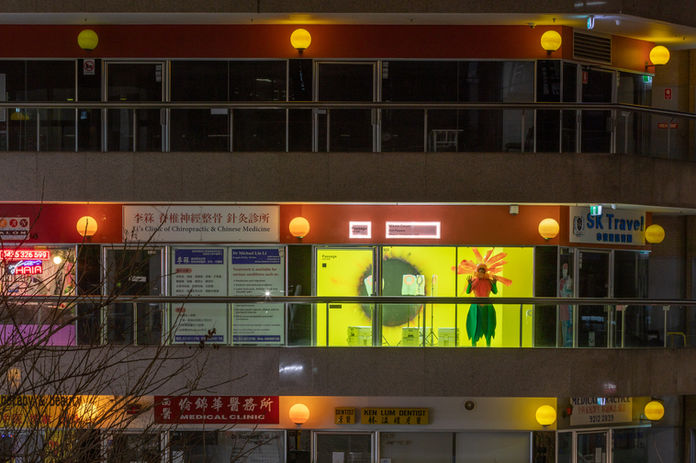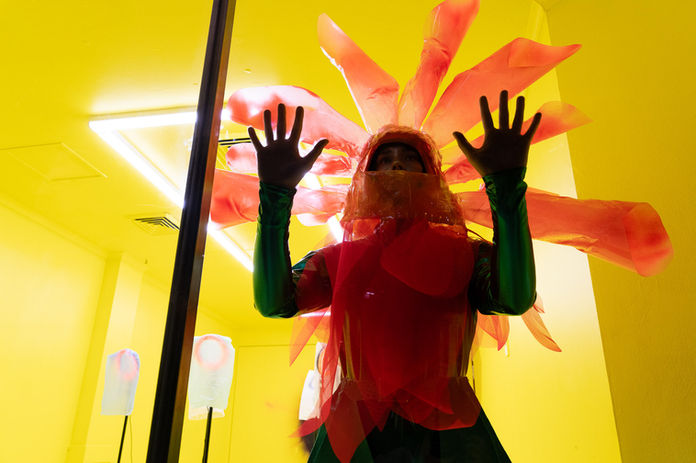
Mikala Dwyer
Shit Flowers
8 August - 14 September, 2025
Mikala Dwyer’s installations are often charged with playful provocation, but beneath their exuberance lies something more occult, more unruly. Her sculptural arrangements pull at the edges of logic and propriety, using the everyday as a gateway into the psychic, the social, and the unseen. Drawing on a long-held interest in modernist spatial language, Dwyer builds sites that feel at once theatrical and deeply intimate. These are works that pulse with relational energy, ambiguity, and quiet acts of defiance.
In Shit Flowers, the gallery is transformed into a kind of digestive theatre. In the centre, a ring of grey objects, each topped with a selfie light and ghosted over with plastic bags, glows like a formation of spectral blooms. A viscous substance is smeared across the windows, blurring the thin boundary between inside and out. The space hums with a strange ceremonial logic, somewhere between séance, shrine, and schoolyard joke.
A central reference in Shit Flowers is the zinnia flower grown aboard the International Space Station in 2016. It was the first to bloom in zero gravity, but not without difficulty. The plant began to fail under the strict scientific protocols developed on Earth. Only when astronaut Scott Kelly was permitted to care for it informally, responding to its needs with instinct rather than instruction, did it begin to thrive. For Dwyer, this shift away from control and toward attentiveness reveals something fundamental about how life persists. Beauty in these conditions wasn’t a byproduct; it became essential.
These ideas ripple through the installation. Care is treated not as a sentimental gesture, but as a kind of resistance. The work isn’t asking how we survive, but what we hold onto in order to stay human. The absurd theatre of space becomes a mirror for our own rituals, where meaning is improvised in the face of pressure, containment, and collapse. There is a seduction in imagining the end, an erotics in the apocalyptic. Shit Flowers lingers in that tension between surrender and insistence, between ruin and renewal.
Inside this chamber, Dwyer’s daughter, Olive, performs. Costumed and enclosed within the installation, she is present during the exhibition’s opening and public programs. Her role is neither scripted nor passive. Instead, she introduces a shifting, human element that alters how the work is encountered. Intimacy becomes infrastructure. The personal unsettles the symbolic.
Shit Flowers doesn’t set out to shock or to moralise. It works more slowly, metabolising its materials and ideas. The gallery becomes a sealed ecosystem where waste is not discarded, but returned to the cycle. Meaning remains suspended. The question “is it shit?” lingers, not as a provocation, but as part of the atmosphere. The answer doesn’t arrive. It doesn’t need to.
Installation and Performance photography by Jessica Maurer & David Suyasa
About The Artist
Mikala Dwyer’s compounds invite open-ended interaction and take the viewer across boundaries of time, space and geography. While playful and exuberant on the surface, they almost always impel us to imagine something darker beneath—or above. Ordinary and familiar materials draw us in, transformed so as to bring attention to the unseen or occult or what society banishes from view. Emerging from a deep and disobedient engagement with modernist form and space, Dwyer’s works have a relationship at their heart and have been described as ‘profoundly sociable’.
Her many exhibitions internationally include The Recent, Talbot Rice Gallery, Edinburgh, 2023-4: Ichiahara Art + Mix Triennale, Japan, Blessed Be, MOCA Tucson, USA (2018); The End of the 20th Century, The Best is Yet to Come—A Dialogue with the Marx Collection, Hamburger Bahnhof, Berlin (2013); FaceUp: Contemporary Art from Australia at Hamburger Bahnhof, Berlin (2003); VersoSüd at Palazzo Doria Pamphilj, Rome, curated by Franz West (2000); and shows atThe Graz Museum, Austria; Zachęta National Gallery of Art, Warsaw; and ChapterArts Centre, Cardiff, UK. Her work has been selected for the Istanbul Biennale(1995), the Biennale of Sydney (2010 and 2014) and the Adelaide Biennial of Contemporary Australian Art (2010 and 2020)

















